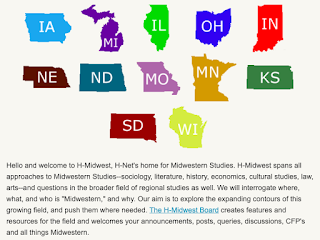“All this fuzziness:” Geospatial Images and Imaginings of “The Midwest”
Image 1. Raygun postcard design.
Image 2. Chris Russell. “Midbest: Midwest is Best.”
Image 3. Scott Santis, Chicago Tribune, 2013.
How do the mixed positionality and porous borders of the Midwest allow us to redefine and reimagine the traditional ways that national political and cultural imaginaries have been structured by geographic dualisms such as coast/heartland and north/south?
– Martin F. Manalansan IV et al.,
“Queering the Middle: Race, Region, and a Queer Midwest,” 2014
The Midwest, then, began as a highly abstract work of the imagination and lingers so today. … I am constantly tinkering with the maps of the Midwest, trying to damp the distortions as much as possible while realizing that each selected vision of the place is a map more detailed than the thing it represents.
– Michael Martone, “Correctionville, Iowa” 1991
The Midwestern United States is often seen not as a place, but a region between places, a vast expanse of normality between the extremes of either coast. Geographically, Midwestern identity is… amorphous.
– Tristan Shook, “Mapping the Midwest,” 29 July 2013
A U.S. Geological Survey expeditionary force announced Tuesday that it has discovered a previously unknown and unexplored land mass between the New York and California coasts known as the “Midwest.”
– The Onion, “‘Midwest’ Discovered Between
East And West Coasts,” 6 July 2005
In the 2013 film Man of Steel, Superman says, “I grew up in Kansas... I'm about as American as it gets.” Spending his childhood in the Midwest helps define Superman as quintessentially American, but the region is often considered a vast, empty expanse in the middle of nowhere. The tension between “as American as it gets” and “the middle of nowhere” are manifest in visual culture artifacts representing the Midwest. In some cases, the entire Midwest is missing from maps, as Jason Heppler noted in his 2017 keynote lecture to the Midwestern History Association, “Mapping the Midwest.” Similarly, Jon K. Lauck laments the Midwest as a “lost region” of history, while the satirical publication The Onionlampoons coastal stereotypes of the Midwest as an “unknown and unexplored land mass.” On the other hand, the Iowa-based graphics company Raygun refers to the Midwest with glowing rhetoric, calling the region “God’s Gift to Planet Earth!” on a postcard and book by the same name (see Image 1). Another of Raygun’s tongue-in-cheek maps, entitled “Midwexit,” suggests that the Midwest should secede from the rest of the United States. John Wilson calls these contrasts a “toxic mix of neglect, dismissive condescension, and compensatory boosterism” unique to the Midwest.
Further propagating the tension of the Midwest as either essential or inconsequential are monikers such as “the heartland” and “flyover country.” Along with designations like middle America, Great Lakes region, Rust Belt, Corn Belt, Grain Belt, Hinterland, Breadbasket, and the historical labels of Middle West and Northwest Territory, one is left wondering where, and what, is “the Midwest?” Many attempts at mapping the Midwest reveal the slippage of its geographical boundaries. As Bill Rankin notes on his website, Radical Cartography, “The sum of all possible Midwests… is incredibly vast, stretching from Newfoundland to New Mexico and Idaho to Georgia” (2013). Some cartographic depictions of the Midwest exclude various states or include only portions of each state; one map includes only an eastern segment of Oklahoma, a political cartoon map shrinks Illinois to enlarge Iowa and Indiana (see Image 3), another map includes the Upper Peninsula but excludes the rest of Michigan, and yet another map omits Michigan’s Upper Peninsula (see Image 2). The extensive interest in mapping the Midwest—Rankin cites over 100 maps of the Midwest to generate his own version of “all possible Midwests”—along with the phenomenon of missing pieces and porous territorial borders show how maps maintain the tension of the Midwest as simultaneously central enough to be over-mapped and marginal enough to be mis-mapped.
Arguably, all maps offer distorted representations of territory. The lack of consensus regarding what constitutes the Midwest makes each map of the region a contested distortion. Is the Midwest perhaps a locus of American identity because of its identification as a blank space on the map to be filled with meaning? Conversely, is the region overflowing with meanings? How do maps promote or challenge the toxic tension between neglect and boosterism? Where do we draw the line between “Midwestern” and “East Coast?” Is it necessary to define the geographical and cultural category of “Midwest,” and is such an undertaking even possible? How do maps of this contested region reflect and reify or subvert and challenge cartographic practices more broadly? These questions guide my research into and visual analysis of maps of the Midwest in my proposed chapter.




Comments
Post a Comment